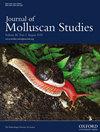Fine-scale genetic structure of the freshwater snail Promenetus exacuous in the New York State region: the influences of historical colonization, habitat connectivity and dispersal ability
IF 1.2
4区 生物学
Q2 MARINE & FRESHWATER BIOLOGY
引用次数: 0
Abstract
The pulmonate freshwater snail Promenetus exacuous (Planorbidae) has a widespread patchy distribution throughout much of North America, including New York State and the surrounding areas. Minimal life history information exists for the species in this region and information on its genetic diversity and structure is currently lacking for any portion of its range. We examined the species’ reproductive behaviour, genetic diversity and population structure throughout New York and western Connecticut using cytochrome c oxidase subunit I (COI) haplotypes (241 snails) and 10 microsatellite loci (312 snails). Throughout the region, P. exacuous is a single, primarily outcrossing species with relatively high within-population genetic diversity. Populations are genetically differentiated and composed of divergent COI lineages. The region was colonized after the Wisconsin glacial retreat by snails from multiple, historically isolated populations and Pleistocene events played a major role in the historical diversification of lineages. Subsequent dispersal has likely been facilitated by birds and humans, but contemporary gene flow is low, resulting in genetic differentiation even among geographically proximate sites. Our data reveal that complex interactions between historical and contemporary processes contribute to the overall patterns of genetic diversity in freshwater snails.纽约地区淡水蜗牛Promenetus的精细遗传结构:历史殖民、栖息地连通性和扩散能力的影响
呼吸淡水蜗牛Promenetus exacous (Planorbidae)在北美的大部分地区都有广泛的斑块分布,包括纽约州和周边地区。该地区物种的生活史资料极少,其遗传多样性和结构资料目前在其分布范围的任何部分都缺乏。利用细胞色素c氧化酶I亚基(COI)单倍型(241只钉螺)和10个微卫星位点(312只钉螺)对纽约和康涅狄格州西部钉螺的生殖行为、遗传多样性和种群结构进行了研究。在整个区域内,白杨是一个主要的异交种,种群内遗传多样性相对较高。种群是遗传分化的,由不同的COI谱系组成。在威斯康辛冰川消退后,该地区被来自多个历史上孤立的种群的蜗牛殖民,更新世事件在历史上的谱系多样化中发挥了重要作用。随后的扩散可能是由鸟类和人类促成的,但当代基因流动较低,导致即使在地理上接近的地点之间也存在遗传分化。我们的数据表明,历史和当代过程之间的复杂相互作用有助于淡水蜗牛遗传多样性的总体模式。
本文章由计算机程序翻译,如有差异,请以英文原文为准。
求助全文
约1分钟内获得全文
求助全文
来源期刊

Journal of Molluscan Studies
生物-动物学
CiteScore
3.00
自引率
8.30%
发文量
36
审稿时长
3 months
期刊介绍:
The Journal of Molluscan Studies accepts papers on all aspects of the study of molluscs. These include systematics, molecular genetics, palaeontology, ecology, evolution, and physiology. Where the topic is in a specialized field (e.g. parasitology, neurobiology, biochemistry, molecular biology), submissions will still be accepted as long as the mollusc is the principal focus of the study, and not incidental or simply a convenient experimental animal. Papers with a focus on fisheries biology, aquaculture, and control of molluscan pests will be accepted only if they include significant advances in molluscan biology. While systematic papers are encouraged, descriptions of single new taxa will only be considered if they include some ‘added value’, for example in the form of new information on anatomy or distribution, or if they are presented in the context of a systematic revision or phylogenetic analysis of the group.
 求助内容:
求助内容: 应助结果提醒方式:
应助结果提醒方式:


